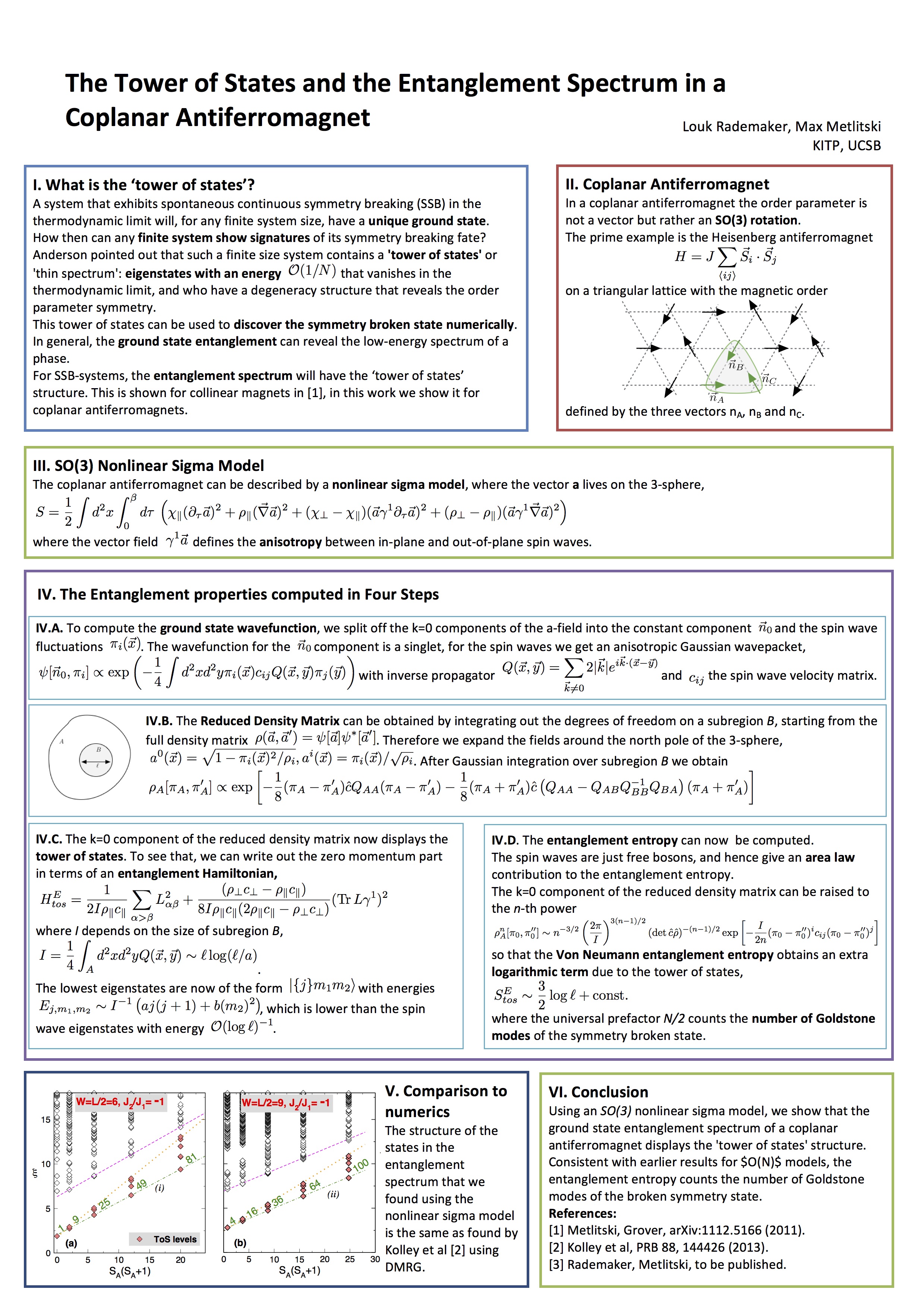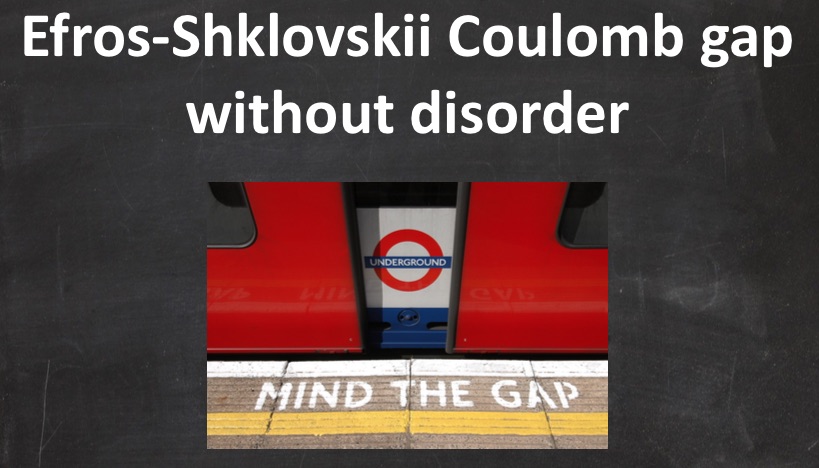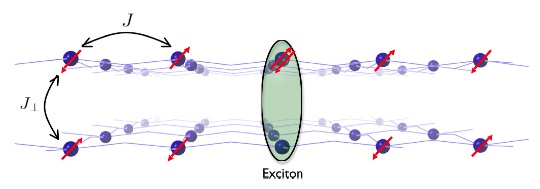 From June 1 to June 5, 2015, the KITP hosted the conference ‘Closing the entanglement gap: Quantum information, quantum matter, and quantum fields,’ where I presented a poster on my recent (unpublished) work on the entanglement spectrum of a coplanar antiferromagnet. The entanglement entropy attains a logarithmic term from the tower of states, proportional to the number of Goldstone modes, the entanglement spectrum represents the full SO(3) symmetry of the tower of states.
From June 1 to June 5, 2015, the KITP hosted the conference ‘Closing the entanglement gap: Quantum information, quantum matter, and quantum fields,’ where I presented a poster on my recent (unpublished) work on the entanglement spectrum of a coplanar antiferromagnet. The entanglement entropy attains a logarithmic term from the tower of states, proportional to the number of Goldstone modes, the entanglement spectrum represents the full SO(3) symmetry of the tower of states.
Presentation, Cafe KITP: Quasiparticles

At 7 May 2015 I gave a public outreach talk for Café KITP at Club Soho in Santa Barbara, for a general audience, with the title ‘Quasiparticles – The Dreams That Stuff is Made Of‘. The idea is that I showed how in solid materials all new kind of ‘fundamental’ particles can arise known as ‘quasiparticles’. In fact, we can engineer any kind of particle – even particles that do not exist in the theory of fundamental particles (the Standard Model) like magnetic monopoles and ‘anyons’. The existence of quasiparticles underlies all modern electronic technology and will give rise no new technologies such as quantum computers.
arXiv preprint: Impurity Bound States and Greens Function Zeroes as Local Signatures of Topology
Title: Impurity Bound States and Greens Function Zeroes as Local Signatures of Topology
Abstract: We show that the local in-gap Greens function of a band insulator G0(ϵ,k∥,r⊥=0), with r⊥ the position perpendicular to a codimension-1 or -2 impurity, reveals the topological nature of the phase. For a topological insulator, the eigenvalues of this Greens function attain zeros in the gap, whereas for a trivial insulator the eigenvalues remain nonzero. This topological classification is related to the existence of in-gap bound states along codimension-1 and -2 impurities. Whereas codimension-1 impurities can be viewed as ‘soft edges’, the result for codimension-2 impurities is nontrivial and allows for a direct experimental measurement of the topological nature of 2d insulators.
Reference: Robert-Jan Slager, Louk Rademaker, Jan Zaanen, Leon Balents, arXiv:1504.04881 (2015)
Presentation: Efros-Shklovskii Gap without disorder
At the APS March Meeting 2015 I presented recent work on the Efros-Shklovskii Gap without disorder.

Abstract: Certain models of frustrated electron systems have been shown to self-generate glassy behavior, in the absence of disorder. Possible candidate materials contain quarter-filled triangular lattices with long-range Coulomb interactions, as found in the θ-family of organic BEDT-TTF crystals. In disordered insulators with localized electronic states, the so-called Coulomb glass, the single particle excitation spectrum displays the well-known Efros-Shklovskii gap. The same excitation spectrum is investigated in a class of models that display self-generated electronic glassiness, showing pseudogap formation related to the Efros-Shklovskii Coulomb gap. Our study suggests universal characteristics of all electron glasses, regardless of disorder.
arXiv preprint: Glassy dynamics in geometrically frustrated Coulomb liquids without disorder
Title: Glassy dynamics in geometrically frustrated Coulomb liquids without disorder
Abstract: We show that introducing long-range Coulomb interactions immediately lifts the massive ground state degeneracy induced by geometric frustration for electrons on quarter-filled triangular lattices in the classical limit. Important consequences include the stabilization of a stripe-ordered crystalline (global) ground state, but also the emergence of very many low-lying metastable states with amorphous “stripe-glass” spatial structures. Melting of the stripe order thus leads to a frustrated Coulomb liquid at intermediate temperatures, showing remarkably slow (viscous) dynamics, with very long relaxation times growing in Arrhenius fashion upon cooling, as typical of strong glass formers. On shorter time scales, the system falls out of equilibrium and displays the aging phenomena characteristic of supercooled liquids above the glass transition. Our results show remarkable similarity with the recent observations of charge-glass behavior in ultra-clean triangular organic materials of the θ-(BEDT-TTF)2 family.
Presentation: Self-generated electron glasses in frustrated organic crystals
This are the Powerpoint slides of a talk that I gave at the Washington University in St. Louis, and later at the Lorentz Institute, Leiden University, The Netherlands. The abstract was:
Glass, like ordinary window glass, is known for thousands of years, yet it lacks a universal physical description. We do know that unlike normal phases of matter – think of gas, liquid, solids – a glass cannot reach its state of lowest free energy. This is due to a loss of ergodicity, and can also happen in a many-electron system. Usually electron glasses are considered in the presence of disorder, yet last year it was shown that a group of clean organic crystals (known as theta-(BEDT-TTF)_2MM’-(SCN)_4 with M=Tl,Rb,Cs and M’=Co,Zn) also display glassy behavior. We will discuss those results, including the Arrhenius behavior of the relaxation time. After that, we will explain the self-generated glassy physics in terms of frustration arising from the triangular lattice and the Coulomb interaction between the electrons. Mean field theory, exact diagonalization and Monte Carlo simulations provide a quantitative picture of this particular clean electron glass.
Download the powerpoint file (6MB) here: Triangular Glasses
Publication: Bilayer Excitons in Two-Dimensional Nanostructures for Greatly Enhanced Thermoelectric Efficiency
Title: Bilayer Excitons in Two-Dimensional Nanostructures for Greatly Enhanced Thermoelectric Efficiency
Abstract: Currently, a major nanotechnological challenge is to design thermoelectric devices that have a high figure of merit. To that end, we propose to use bilayer excitons in two-dimensional nanostructures. Bilayer-exciton systems are shown to have an improved thermopower and an enhanced electric counterflow and thermal conductivity, with respect to regular semiconductor-based thermoelectrics. We suggest an experimental realization of a bilayer-exciton thermocouple. Based on current experimental parameters, a bilayer-exciton heterostructure of p- and n-doped Bi2Te3 can enhance the figure of merit an order of magnitude compared to bulk Bi2Te3. Another material suggestion is to make a bilayer out of electron-doped SrTiO3 and hole-doped Ca3Co4O9.
Reference: Kai Wu, Louk Rademaker, and Jan Zaanen, Phys. Rev. Applied 2, 054013 (2014).
arXiv preprint: The Instability of a Quantum Superposition of Time Dilations
Title: The Instability of a Quantum Superposition of Time Dilations
Abstract: Using the relativistic concept of time dilation we show that a superposition of gravitational potentials can lead to nonunitary time evolution. For sufficiently weak gravitational potentials one can still define, for all intents and purposes, a global coordinate system. A probe particle in a superposition of weak gravitational fields will, however, experience dephasing due to the different time dilations. The corresponding instability timescale is accessible to experiments, and can be used as a degree of macroscopicity. Finally, we suggest an experiment with smoothly tunable amplification in a microwave interferometer that allows a quantitative study of the quantum to classical boundary.
arXiv preprint: How bilayer excitons can greatly enhance thermoelectric efficiency
Title: How bilayer excitons can greatly enhance thermoelectric efficiency
Abstract: Currently, one of the major nanotechnological challenges is to design thermoelectric devices that have a high figure of merit. To that end, we propose to use bilayer excitons. Bilayer exciton systems are shown to have an improved thermopower and an enhanced electric counterflow and thermal conductivity, with respect to regular semiconductor-based thermoelectrics. Here we present a roadmap towards experimental realization of a bilayer exciton thermocouple. A bilayer exciton heterostructures of p- and n-doped Bi2Te3 can have a figure of merit zT∼60. Another material suggestion is to make a bilayer out of electron-doped SrTiO3 and hole-doped Ca3Co4O9.
Reference: Kai Wu, Louk Rademaker, Jan Zaanen; arXiv:1401.7770.
Publication: Exciton condensation in strongly correlated electron bilayers
Title: Exciton condensation in strongly correlated electron bilayers
Abstract: We studied the possibility of exciton condensation in Mott insulating bilayers. In these strongly correlated systems, an exciton is the bound state of a double occupied and empty site. In the strong coupling limit, the exciton acts as a hard-core boson. Its physics is captured by the exciton t-J model, containing an effective XXZ model describing the exciton dynamics only. Using numerical simulations and analytical mean-field theory, we constructed the ground-state phase diagram. Three homogeneous phases can be distinguished: the antiferromag- net, the exciton checkerboard crystal, and the exciton superfluid. For most model parameters, however, we predict macroscopic phase separation between these phases. The exciton superfluid exists only for large exciton hopping energy. Additionally, we studied the collective modes and susceptibilities of the three phases. In the superfluid phase, we find the striking feature that the bandwidth of the spin-triplet excitations, potentially detectable by resonant inelastic x-ray scattering (RIXS), is proportional to the superfluid density. The superfluid phase mode is visible in the charge susceptibility, measurable by RIXS or electron energy loss spectroscopy (EELS).



